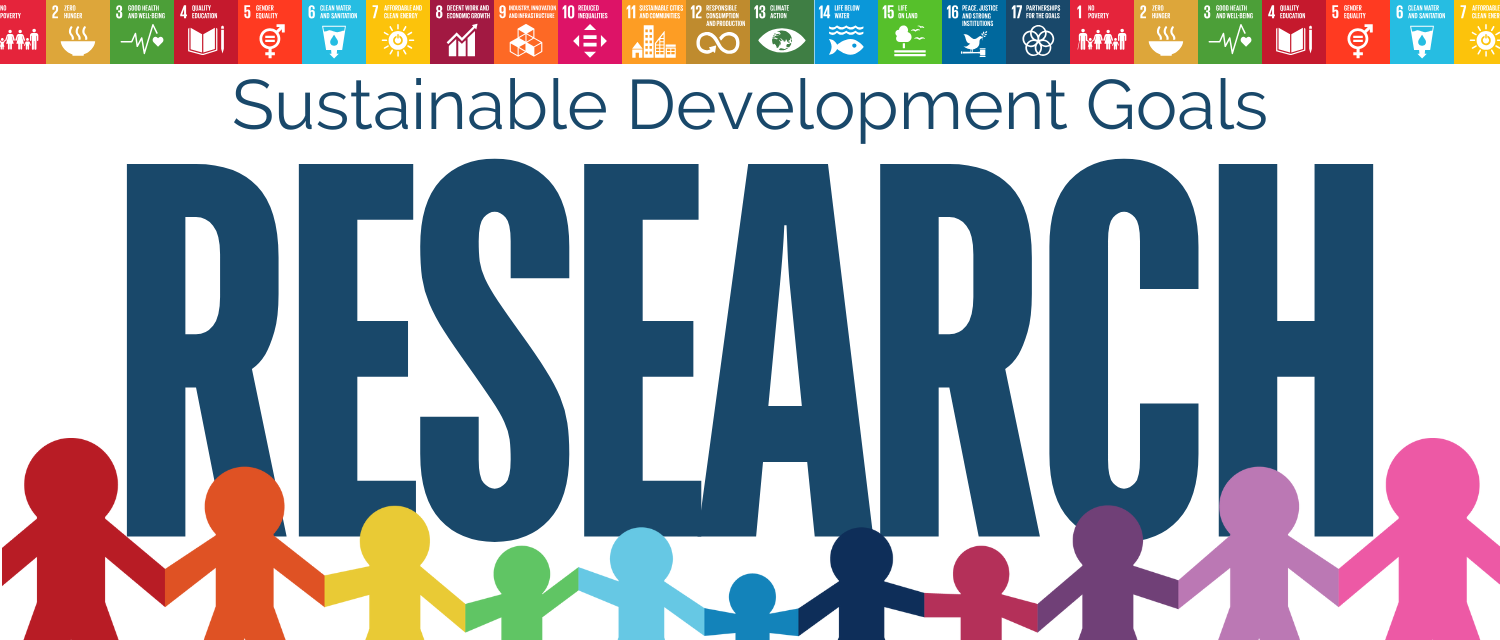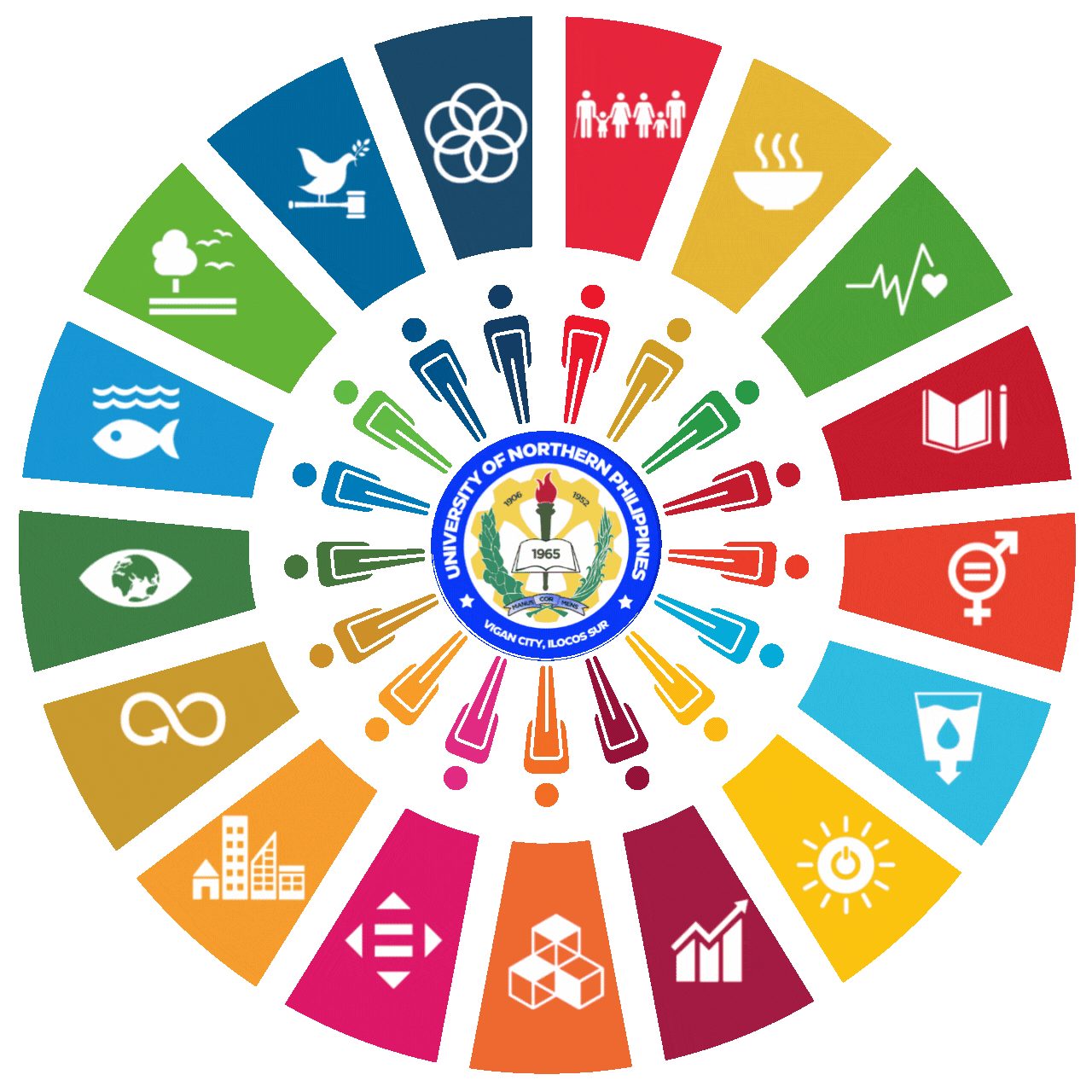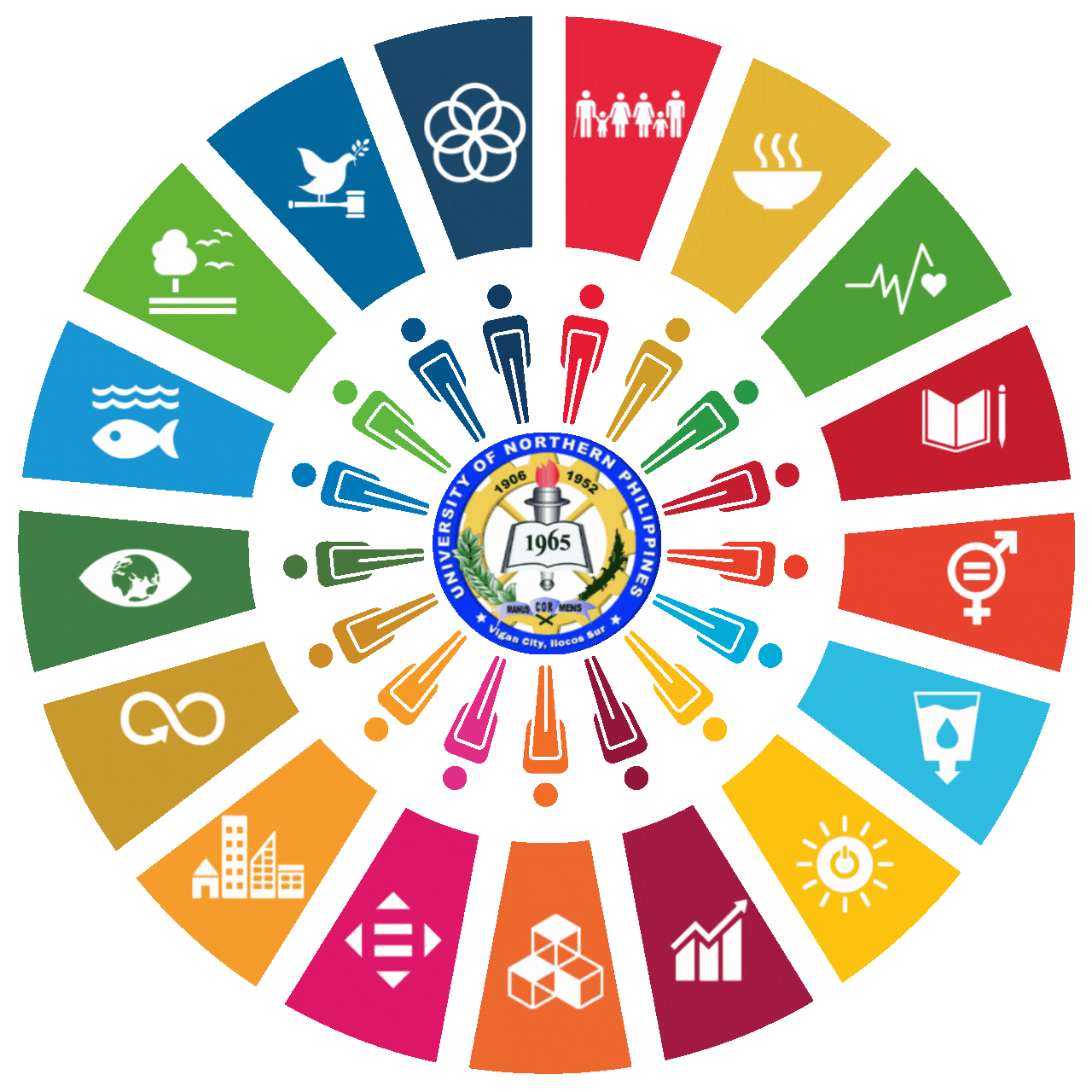

SDG 8 - DECENT WORK NAD ECONOMIC GROWTH
The University of Northern Philippines (UNP) demonstrates a strong commitment to Sustainable Development Goal 8: Decent Work, and Economic Growth through its comprehensive approach to education, skills development, and community engagement.
Tracer Study and Employment of the Teacher Education Graduates of a University in North Luzon, Philippines
Proponents: Corazon G. Pardo, Luzviminda P. Relon
Abstract
The quality of education is measured by the employment and establishment of sustainable career paths for graduates. Tracer studies allow higher education institutions to generate integrated data on their graduates’ employment while also reflecting the quality of education they provide. This study traced the employment profile of the 2018 Teacher Education graduates at a University in North Luzon, Philippines. It also analyzed the graduates’ suggestions about the curriculum and selected employers’ feedback. The study utilized the descriptive-survey method of research, questionnaire, and interviews. Results showed that most respondents are 21 years old, female-dominated, single, and passed the licensure examination for teachers and the Civil Service Professional Examination. More than half of the employed respondents landed their first teaching job within six months after graduation in private schools, handling course-related subjects as contractual/provisional and receiving low salaries. Self-employed and unemployed graduates are waiting for job opportunities to
exercise their careers in public schools. English communication, professional and significant subjects closely related to effective teaching and learning are essential to them after graduation. Provision for better facilities and equipment, curriculum emphasizing the development of 21st-century skills, exposure to lesson plans and school forms preparation, and presence of specialized teachers to handle major subjects are recommendations to improve the curriculum. Similarly, employers suggested better classroom management, reporting, and personal and professional skills development for the graduates.
Keywords: Employment, career opportunities, quality of education
Uncovering Health Problems of UNP Personnel
Proponents: Ernesto Tagorda Jr., Glenda Tagorda, Marsha Michelle Cabuena, Kriza Rosette A. Cadorna
Abstract
The study aimed to determine the uncovered health problems of University of Northern Philippines (UNP) employees. The retrospective cohort study included UNP employees who took the 2021 Annual Medical Exam (AME). Data on their demographics, medical history, test results, and examination findings were collected. Descriptive statistics were used to present the subjects’ profile and overall health. The simple correlation was used to describe the relationship between the medical problems uncovered and the respondents’ profile. Generally, the respondentsare fit to work. However, more than half of the respondents had unsatisfactory health status, and hypertension was the most prevalent cause of morbidity. The study has uncovered diseases of the employees with Urinary tract infection (UTI) as the most uncovered disease.Furthermore, the research reveals a highly significant relationship between respondents’ age and undiagnosed heart problems or diabetes mellitus (DM). Additionally, there is a highly significant relationship between sex and undiagnosed health conditions. Moreover, hypercholesterolemia, hypertension, and anemia are significantly related to the type of employment. The AME has uncovered several health problems which may contribute to employees’ poor work performance. Thus, early detection and treatment of any health problem can improve the health and productivity of the university workforce.
Keywords: health status, uncovered health problems, annual medical exam
Spoken-Digit Classification using Artificial Neural Network
Proponents: Aunhel John M. Adoptante, Arnie M. Baes, John Carlo A. Catilo, Patrick Kendrex L. Lucero, Anton Louise P. De Ocampo, Alvin S. Alon, Rhowel M. Dellosa
Abstract
Audio classification has been one of the most popular applications of Artificial Neural Networks. This process is at the center of modern AI technology, such as virtual assistants, automatic speech recognition, and text-to-speech applications. There have been studies about spoken digit classification and its applications. However, to the best of the author’s knowledge, very few works focusing on English spoken digit recognition that implemented ANN classification have been done. In this study, the authors utilized the Mel-Frequency Cepstral Coefficients (MFCC) features of the audio recording and Artificial Neural Network (ANN) as the classifier to recognize the spoken digit by the speaker. The Audio MNIST dataset was used as training and test data while the Free-Spoken Digit Dataset was used as additional validation data. The model showed an F-1 score of 99.56% accuracy for the test data and an F1 score of 81.92% accuracy for the validation data.
Keywords: artificial neural networks, signal processing, MFCC, speech recognition
Narratives of Buri Weavers in San Juan: A Phenomenology
Proponents: Ma. Jesusa R. Unciano, Honorato R. Patubo, Charito R. Alconis, Marites I. Duquinal, Imelda Q. Nesperos
Abstract
Assuming a phenomenological stance that adopted an inductive approach (Creswell, 1998) and descriptive phenomenology (Christensen et al. (2017), this study explored and described the lived experiences of the resident-buri weavers of San Juan, Ilocos Sur, Philippines, determined the participants’ view of buri weaving, the Ilocano identity mirrored by the industry, and lexical items associated with the cultural practice. The analysis of their lived experiences revealed that the weavers have both positive and negative views of the panaglaga ti silag, representing their view of the industry and reflecting the defining Ilokano traits. Also, the narratives of the Buri weavers reflect the dynamics of their engagement in this treasured cultural practice and mirror the Ilokano traits. Government agencies and educational institutions should provide financial and technical assistance for the buri industry to continue thriving and for the weavers to keep improving their artistry and weaving skills. Through it, the silag weaving industry will continue to serve as a bridge that provides the missing link between the past, present, and future of the people in this part of the Province of Ilocos Sur. Also, 50 Ilokano buri weaving-related terminologies surfaced and were compiled in a supplementary material called Buri: Preserved Language.
Keywords: narratives, culture, buri industry, experiences, Philippines/Asia
Predicting Countries with Low and High Robbery Rates Using Discriminant Analysis
Proponents: Joseph G. Taban, Dolores R. Bersamina, Randolf M. Agup
Abstract
Crime such as robbery has been identified as one of the socio-economic problems across the world, which adverse social, economic, and family conditions have caused. Using discriminant analysis, this study proposed a model for classifying and predicting countries with low and high robbery rates. Robbery rates in 2018 of 42 countries across the world have been extracted from United Nations Office on Drugs and Crime as the dependent variable. Meanwhile, the independent variables included the unemployment rate, average household size, and poverty index. The study originally classified 32 countries with low and 10 with high robbery rates. Pretesting was employed, and the results showed that all the assumptions for discriminant analysis were fulfilled. Using standardized beta and Wilk’s Lambda, the average household size is the best predictor variable, while the unemployment rate is the least predictor variable. The overall prediction function model is significant. The classification results by discriminant analysis algorithm for groups with low and high robbery rates show that the proposed model correctly predicts 78.6% of the robbery rates of countries based on the three characteristics, such as their unemployment rate, average household size, and poverty index.
Keywords: Robbery rates, discriminant analysis, unemployment rate, average household size, poverty index
The Science Teachers Engagement via Extension (SciTEE) Project: An Impact Study Using the Model of Change
Proponents: Edelyn Alicar Cadorna, Erwin Frando Cadorna, Janet Tabasan Molina
Abstract
Using the theory of change, the impact of the Science Teachers Enhancement via Extension (SciTEE) Project of a state university in the northern part of Luzon, Philippines, was evaluated. Through the mixed method of research, the study investigated the extension profile, project level of implementation, outputs, outcomes, and impact after being implemented for five years. The participants of the different extension activities were the respondents. The process of triangulation was utilized to gather the data needed. Through the project, the beneficiaries enriched their knowledge of selected science content, developed their ICT skills in teaching, acquired knowledge and skills on the proper use of science equipment, and developed their skills in research and in making instructional
materials. The Project contributed to the capacity building of the beneficiaries, their social and economic development, lifelong learning skills, and generally contributing to the global goal of preparing teachers for 21st-century learning.
Keywords: 21st-century teaching skills, model of change, extension program, teacher enhancement, impact assessment.
Heritage on the Ground: A Thirdspace Reading of Calle Crisologo, Vigan City, Philippines
Proponent: Mark Louie Tabunan
Abstract
Christoph Brumann and David Berliner, in their book World Heritage on the Ground: Ethnographic Perspectives (2016), ask what World Heritage (WH) does on the ground far away from the meeting halls of the WH Committee. This article explores the ways in which WH moves and breathes on the ground of Calle Crisologo, Vigan City in northern Philippines. Utilizing participant observation and
key informant interviews and building on Edward Soja’s notion of Thirdspace, it aims to unpack differences of meanings with regard to the ways WH gets negotiated by locals. The themes of remembrances, counter-memory, impacts and meanings of WH, rootedness and counter practices, and postcoloniality problematize and enrich WH’s relationship with local histories, memories, societies, identities, and economies. Shown through the variegated accounts are the ways in which people’s engagement with the street turns it into a fecund and volatile, real and imagined lifeworld of experiences. Findings and lessons relate well to heritage’s meaning, value, and significance – such as, for instance, the ways that local people’s voices can be better valued for more sustainable and inclusive heritage, culture, and memory of Vigan City and elsewhere.
Keywords: World Heritage; thirdspace; Calle Crisologo; Vigan City; urban space
Cultural Tangible Properties: The Development of the Candon Heritage Resources conservation Plan
Proponents: Ludivina Abaya Lozano
Abstract
The City of Candon in Ilocos Sur, Philippines, is rich in culturally built heritage, particularly houses of ancestry. The City identifies ancestral houses, while other buildings and structures are not included in the list but can already be considered part of the culturally built heritage. Collectively, these cultural resources are within a proposed heritage district of the City, including a heritage growth corridor–where the high concentration of such resources is located — that may serve as a visual representation and act as a living museum of the area. This study formulated a proposed Heritage Resources Conservation Plan to preserve and protect the identified built heritage resources in Candon City. A field survey was conducted to identify and map the local heritage resources and their cultural significance. Upon identification of the City’s heritage district, several guidelines regarding further development in the area, especially along the heritage corridor, were recommended to preserve and protect these cultural resources from possible deterioration and destruction.
Keywords: Cultural Tourism, Heritage Zone, Built Heritage, Local heritage Resources
Social Support and Techno-stress of Faculty Members in a State University in Northern Luzon, Philippines
Proponents: Alexandria Blake C. Real-Pisalbo, Mico M. Molina, Kristina Camille V. Pacris-Quitevis, Aldrin S. Jaramilla
Abstract
This descriptive-correlational study investigates the relationship between social support and technostress among 260 University of Northern Philippines faculty members, aiming to propose an action plan for the institution. Findings reveal a notable level of technostress experienced by UNP faculty, with factors like usefulness, reliability, presenteeism, and pace of change significantly impacting them, while complexity does not. Despite a moderately high level of perceived social support derived from family, friends, and significant others, there is no significant correlation between received social support and technostress dimensions. However, a weak negative relationship is observed between perceived social support and technostress. The study concludes that while The Safe Space Project addresses technostress, the dynamic technological workplace underscores the necessity for a dedicated University Psychologist. Such a professional can offer tailored guidance to faculty members, ensuring a comprehensive approach to mental health support in the digital age.
Keywords: Social Support, Technostress, Faculty, State University, Northern Luzon
A Sequential-Explanatory Study on the Financial Literacy of Women Farmers in Ilocos Sur
Proponents: Maria Sofia Guiller T. Tomaneng, Reynalyn D. Amistad, Jasmine Mild B. Ato, Sophia O. Chan, Francine Nicole C. Custodio, Bonifacio Jonelle D. Peruna, Adrienne Bianca C. Solian, Christian S. Domondon
Abstract
Women farmers are underrepresented in Philippine society. Their existence and hard work are often disregarded and undervalued. This is apparent in localities where agriculture is the leading source of income. This sequential-explanatory study inquired about women farmers’ financial literacy level and lived experiences in four municipalities in the 1st District of Ilocos Sur, where most women farmers are located. The study utilized a problem-solving test and survey questionnaires to determine the literacy level of women farmers in terms of knowledge, attitude and behavior, and skills. At the same time, a semi-structured interview was done for the qualitative aspect of the study. Frequency and percentage, mean, and thematic analysis were used to analyze the data. Results showed that women farmers exhibited low financial knowledge and skills and a high financial attitude and behavior, resulting in an average financial literacy. Challenges influenced by their low financial knowledge and skills were due to environmental and social factors. Meanwhile, their high financial attitude and behavior positively impacted their lived farming experiences. Moreover, their exposure to selling, budgeting, saving, and engaging with banking institutions contributed to their average financial literacy. Therefore, the study recommends programs and training implementations by the government to improve the farmers’ financial literacy further and empower women farmers.
Keywords: Agriculture, financial literacy, mixed-methods, sequential-explanatory, women farmers
Beyond Tangible: Vigan City's Binatbatan Festival: Basis for a Policy Brief
Proponent: Henryson A. Fetalvero
Abstract
Festival conveys encouraging influence in drawing tourists, improving image of destination and supporting local communities. This study scanned “Binatbatan” festival of Vigan City from the point of view of organizers and visitors. Through a case study, the qualitative method was employed to understand the Festival underscoring, its origin, celebration schemes and the challenges on the people and the place, magnifying management strategies for ordinance implementation on various activity related to the culture and tradition of the locality. A Focus Group Discussions and interviews of respondents and visitors conducted were interpreted. The study realized that Festivals evolve through informal sociability; planning and coordination, as well as control, were vital, creating avenues for cultural and artistic appreciation and the formation of social capital, that the festivals shares four common success factors of ambiance, socialization, emotion and reflection; and that planning, budgeting, coordination, promotion as well as control were vital to the celebrations and that festivals created avenues for job generation, cultural and artistic appreciation and formation of social capital. Based on the findings, policy brief that act on the challenges met by the organizers in managing the festivals, were proposed.
Keywords: Festival, Case Study, Event’s Challenges Sustainability, Policy Brief


















